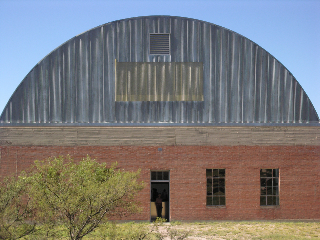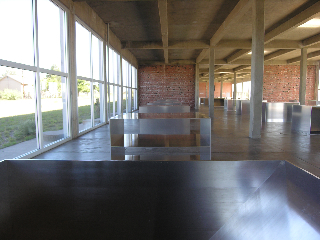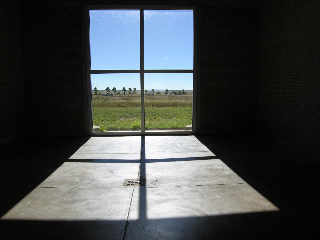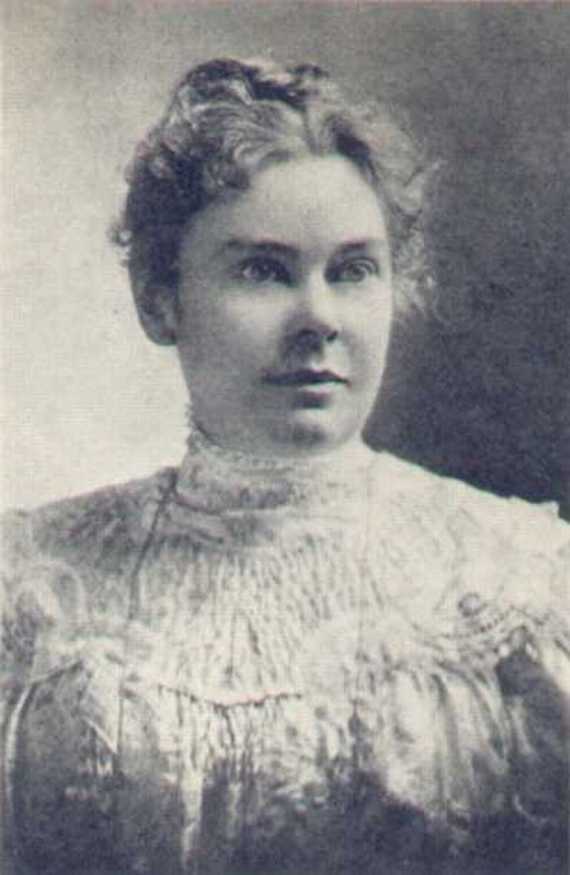I recently made the pilgrimage to what the French would call one of the hauts lieus de l’art: Marfa, Texas. Like any place of pilgrimage worthy of the name, Marfa is remote and difficult to get to. One makes the journey because the artist Donald Judd, beginning in the 1970s, moved his base of operations to this former cattle trading center, gradually buying up several properties in Marfa, Then, with the help of New York’s Dia Foundation, he purchased an entire disused Army base next to the town, over 300 acres of industrial scale warehouses, barrack and office buildings, and scads of empty space. Out of this Texican cattle barony without the cattle, he created living and working spaces for himself, as well as permanent exhibition space for his work and that of a few colleagues and friends.
Like many born east of the 100th meridian, in the green, humid half of the continent, Judd fell in love with the dry crystalline air and unforgiving light of this part of the country, with its high arid plains, its horizons punctuated with mesas and buttes. For certain artists and intellectuals, the Southwest is America’s Provence, a place where (in the American mode) the configuration of the land itself, with its vast spaces, is a kind of liberation. Marfa was Judd’s Arles, and like Van Gogh, Judd dreamt of an artist’s utopia. He didn’t realize his dream, but he did create a series of ideal settings in which art could be displayed entirely on its own terms, without the misguided interference of dealers and curators. With the creation of the Chinati Foundation, Judd put in place an institutional framework for the preservation of his vision after his death.
 Now, years after Judd’s passing in 1994, Chinati is a going concern. For those in the art world, it is an item on the checklist of places to see before you die. I’ve wanted to go there for a long time, but not because I am big fan of Judd’s work or of Minimalism. Judd reached for his Luger whenever he heard the word Minimalism, as well he might, since the term is entirely apt in my view. His work, and that of his brethren, ruthlessly reduced to a set of Platonic essences, provides a minimum of sustenance for the eye. It is a Stoic’s or a Puritan’s bowl of thin porridge. Everything this kind of work has to give you is exhausted by mere moments of looking. Simplification and purification of form, elimination of content and narrative, all this exacts a high price. If, in the end, we look at art for the profound pleasure it gives us, why look at work that has , in an ascetic quest for some ideal, done away with so many of the qualities that make art pleasurable? For me, at least, years of received opinion and the torrents of ink that have been spilled arguing for the far-reaching philosophical significance of Minimalism do nothing to counteract the indifference of my eyes whenever I look at the stuff.
Now, years after Judd’s passing in 1994, Chinati is a going concern. For those in the art world, it is an item on the checklist of places to see before you die. I’ve wanted to go there for a long time, but not because I am big fan of Judd’s work or of Minimalism. Judd reached for his Luger whenever he heard the word Minimalism, as well he might, since the term is entirely apt in my view. His work, and that of his brethren, ruthlessly reduced to a set of Platonic essences, provides a minimum of sustenance for the eye. It is a Stoic’s or a Puritan’s bowl of thin porridge. Everything this kind of work has to give you is exhausted by mere moments of looking. Simplification and purification of form, elimination of content and narrative, all this exacts a high price. If, in the end, we look at art for the profound pleasure it gives us, why look at work that has , in an ascetic quest for some ideal, done away with so many of the qualities that make art pleasurable? For me, at least, years of received opinion and the torrents of ink that have been spilled arguing for the far-reaching philosophical significance of Minimalism do nothing to counteract the indifference of my eyes whenever I look at the stuff.
Why then did I want to go to this place at the back of beyond? Simple. All of Judd’s real strengths as an artist—his finely tuned sense of proportion, his sensitivity to the surface facture and weight of materials, his exquisite, but not fussy, craftsmanship—resonate much more fruitfully in his architectural and design work than in his sculpture. Judd’s plans required the renovation and often radical reconfiguration of existing structures. He also designed and built much of the furniture himself. Seeing the results of this impressive effort in photographs, I found it to be both stark and elegant. Functionality brought his forms to life for me: one of his buildings or even a desk seemed to give me much more to look at (and feel) than his artwork ever did. So off I went to Marfa. And, in the back of my mind, I hoped to be won over by the artwork itself. Maybe, seeing it under Judd’s ideal conditions, my eyes would be opened to its virtues. Only a fool closes his mind completely to new sources of pleasure. Such was my thinking before arriving in Marfa itself.
 One is allowed to view the art on the former military base only as part of a tour run by Chinati. There are several permanent installations; three of these best exemplify Judd’s intentions. One is by Dan Flavin, an array of light sculptures in six barrack buildings, which is conceived of as a single work. The second is in a warehouse where a display of John Chamberlain’s wadded up automobile sculptures occupies a basilica-like space. Then, there is Judd’s own work. The centerpiece of his project in Marfa is housed in two monumental buildings, the Artillery Sheds. It comprises one hundred aluminum boxes, identical in size, lined up in three evenly spaced rows running the length of these very long buildings. Within this matrix (which includes the building itself) of Euclidean geometry gone apeshit, the boxes themselves are far from being clones of each other. Sometimes sides are open, or half-open and half-closed. The internal space of a box might be bisected by one or more horizontal, vertical or oblique planes. The metal boxes, like Flavin’s piece, are meant to be taken in as a single work on a heroic scale. Judd wanted Chinati to be a place where he, and his friends, could make real their grandest ambitions, giving them permanent form, unfettered by worldly constraints. Clearly, in this, he succeeded.
One is allowed to view the art on the former military base only as part of a tour run by Chinati. There are several permanent installations; three of these best exemplify Judd’s intentions. One is by Dan Flavin, an array of light sculptures in six barrack buildings, which is conceived of as a single work. The second is in a warehouse where a display of John Chamberlain’s wadded up automobile sculptures occupies a basilica-like space. Then, there is Judd’s own work. The centerpiece of his project in Marfa is housed in two monumental buildings, the Artillery Sheds. It comprises one hundred aluminum boxes, identical in size, lined up in three evenly spaced rows running the length of these very long buildings. Within this matrix (which includes the building itself) of Euclidean geometry gone apeshit, the boxes themselves are far from being clones of each other. Sometimes sides are open, or half-open and half-closed. The internal space of a box might be bisected by one or more horizontal, vertical or oblique planes. The metal boxes, like Flavin’s piece, are meant to be taken in as a single work on a heroic scale. Judd wanted Chinati to be a place where he, and his friends, could make real their grandest ambitions, giving them permanent form, unfettered by worldly constraints. Clearly, in this, he succeeded.
If one is of a mind to, one can follow up the Chinati tour with a late afternoon peek (also guided) at the Block, Judd’s residential compound in town. Behind high adobe walls sits various structures which contain Judd’s library, workspaces ( home to some of his early sculptures) and living space, all widely separated by a vast flat expanse paved with loose cinder rock. You admire the lovely proportions of this enclosed area and the buildings disposed across it, but the mind quails at the thought of crossing this treeless waste on a hot summer day—La Jornada del Muerto in your own backyard.
So, what does all this add up to in the end? This is the question I’ve been mulling over since the middle of the tour itself. I’m afraid that the admirable open-mindedness I boasted of earlier availed me nothing; my mainlining all this Juddiana did not make a convert of me. (Putting aside both the work of the other artists and the architecture, I will focus on Judd’s 100 Boxes alone as emblematic of the whole enterprise.) Certainly, when I entered the first Artillery Shed, I was more affected than I expected. Judd had removed the solid side walls of both buildings, replacing them with rows of large floor-to-ceiling windows, the illumination from which, reflecting off the mirrored surfaces of the boxes and the shiny polished floor, choreographed a dazzling dance of light and shadow. Some of the boxes lost their hard edges, even seemed to dissolve in this play of silvery grays and chiaroscuro blacks, changing constantly as you shifted your viewpoint. Surprisingly, these cold metal boxes were actually quite sensual.
But, after this initial enthusiasm, I soon began to experience box fatigue. Initially assuming an air of the implacable in their machined perfection, the boxes secretly want you to find them fascinating, to like them. However, Judd’s endlessly clever improvisations on the boxes’ structure actually serve to trivialize them. We look at them and their permutations, as isolated instances, forgetting that they are supposed to be components of something much larger. The variety itself sooner or later becomes tiresome and boring, or simply too much to take in. The variations are really just an empty formal strategy, an arbitrary problem the artist set up for himself. They don’t interact with each other, creating a dynamic movement, a musical counterpoint, that plays out through the piece as a whole. Therefore, the boxes never coalesce into a unified experience. As a collection of individual iterations exploring a single idea, the work in the Artillery Sheds is, up to a point, fascinating, but it very quickly becomes just one damn thing after another. The modular premise underlying the work, with its tension between overall unity and the autonomy of each module, was stretched to the breaking point by Judd’s overreaching ambition. Judd was aiming very, very high here, and didn’t make it. As a coherent work of art, I think we have to count 100 Boxes a failure.
This conclusion raises a disturbing question. Why is a failed artistic endeavor being enshrined like this? Judd is an artist who deserves our attention, but the degree of cultural canonization and institutional validation that has been conferred on his work at Marfa is commensurate with the very highest levels of achievement. Who decided that Judd’s legacy is that important? Well, for one, Judd himself, aided and abetted by a coterie of partisans of Judd’s idealist avant-gardism within the rarefied upper echelons of the American art world. Judd’s really big dreams were realized not in response to a deeply felt need in the society at large, or even because of official recognition on the part of the State, but through the decisions of a very small number of self-appointed people with, crucially, access to capital.
 Ultimately, in today’s world, in which society as a whole has no agreed upon use for art, money becomes the sole and final arbiter of value, in art as in everything else. In these circumstances there is tremendous financial incentive to inflate reputations. Nothing new in that observation, but there’s another, mostly unacknowledged, tendency at work here as well. In the post-war decades, for America’s art world taste makers, a driving concern was to demonstrate, to one and all, that this country’s culture had come of age. A great culture requires great artists, but faced with a real paucity in that area, critics, curators and dealers (and artists) worked assiduously to convince themselves and us that many fine second and third-rank artists rightfully deserved to be elevated to the very pinnacles of Mount Parnassus itself. Claims were made for these artists out of all proportion to the work itself. Interesting but limited talents, such as those of Pollack or Johns, were held up as proof that, as an exhausted Europe passed the torch to the New World, America was ready. The money flowed in response to this debasement of the critical coinage, validating it. Because the art world is so insular and small, and the public obliviousness to serious art so nearly complete, there is no external reality check on this process, (which continues to this day, mostly shorn of nationalist content).
Ultimately, in today’s world, in which society as a whole has no agreed upon use for art, money becomes the sole and final arbiter of value, in art as in everything else. In these circumstances there is tremendous financial incentive to inflate reputations. Nothing new in that observation, but there’s another, mostly unacknowledged, tendency at work here as well. In the post-war decades, for America’s art world taste makers, a driving concern was to demonstrate, to one and all, that this country’s culture had come of age. A great culture requires great artists, but faced with a real paucity in that area, critics, curators and dealers (and artists) worked assiduously to convince themselves and us that many fine second and third-rank artists rightfully deserved to be elevated to the very pinnacles of Mount Parnassus itself. Claims were made for these artists out of all proportion to the work itself. Interesting but limited talents, such as those of Pollack or Johns, were held up as proof that, as an exhausted Europe passed the torch to the New World, America was ready. The money flowed in response to this debasement of the critical coinage, validating it. Because the art world is so insular and small, and the public obliviousness to serious art so nearly complete, there is no external reality check on this process, (which continues to this day, mostly shorn of nationalist content).
Was Judd a beneficiary, and Marfa a direct result, of this process? Is Judd’s work, in other words, worthy of the exalted treatment it receives at Chinati? My answers will be plain enough by now. But, don’t take my word for it. Everyone who cares should decide for themselves. However, relatively few people will ever be in a position to do that; because of its remoteness, few will ever go there. Regardless of what you make of my thesis, agree or disagree, this is the paradox at the core of Judd’s self-willed monument. A monument, or a museum, if we care to look at it as such, implies a public, but Chinati’s public is miniscule, a molecular fraction of a population which mostly remains ignorant of the very existence of the place. Undaunted, Chinati sits on its arid upland, its back sublimely turned on everybody except the initiate, and the mildly curious willing to go way out of their way to scratch an itch.
Despite his success, Judd felt that his work and the thought behind it was never fully understood, either by art world professionals or the informed public. Even during his life, this was probably largely true. How much more so now. In response to this incomprehension, the vision he developed for Chinati was a hermetic one, informed by more than a little despair. For all its scale and ambition, what Judd built at Marfa is a refuge from a cruelly indifferent world. Its elite financial underpinnings and its splendid isolation, physically and culturally, from the lives and concerns of most people in this country, speak volumes about the plight of the arts in a society such as ours.







